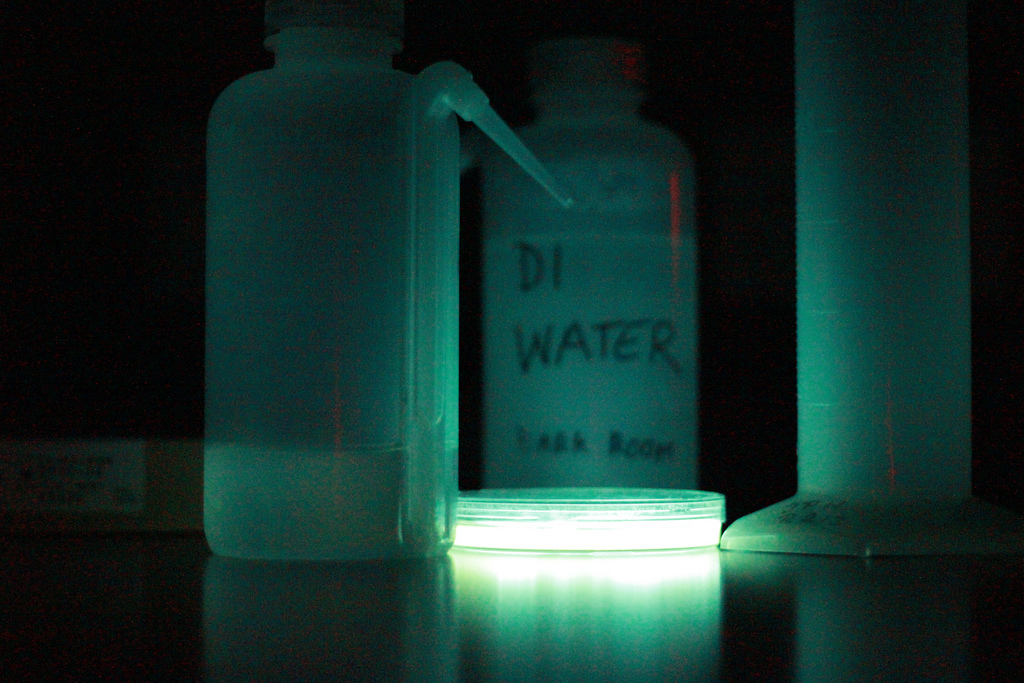Team:Cambridge/Bioluminescence/Bacterial Luciferases
From 2010.igem.org
Peteremmrich (Talk | contribs) |
Peteremmrich (Talk | contribs) |
||
| Line 2: | Line 2: | ||
{{:Team:Cambridge/Templates/headerbar|colour=#386abc|title=Project Vibrio: Introduction}} | {{:Team:Cambridge/Templates/headerbar|colour=#386abc|title=Project Vibrio: Introduction}} | ||
| - | + | ||
'''Project Vibrio''' was designed to create BioBricks from genes involved in bacterial bioluminescence. These so called lux genes are clustered in lux operons and encode enzymes required for the catalysis of light-generating chemical reactions. | '''Project Vibrio''' was designed to create BioBricks from genes involved in bacterial bioluminescence. These so called lux genes are clustered in lux operons and encode enzymes required for the catalysis of light-generating chemical reactions. | ||
==Natural bioluminescent bacteria== | ==Natural bioluminescent bacteria== | ||
| + | [[Image:Phosphoreum_bright.jpg|300px|thumb|right|Vibrio phosphoreum]] | ||
Bioluminescence is a trait found in a number of marine bacteria. Some strains use their ability to emit light to form symbiotic relationships. A number of deep sea fish and squids have specialised <em>light organs</em> which harbour populations of bacteria that help their hosts by emitting light. One such example is the partnership between the Hawaiian Bobtail squid <em>(Euprymna scolopes)</em> and the bacterium <em>Vibrio fischeri</em>. At night squid hunt high in the water column, attacking their prey from above. Vibrio Fischeri is usually found in symbiosis with the Hawaiian Bobtail Squid. The squid uses the light produced by its symbionts to hide the shadow it casts when hunting in top waters in clear moonlit nights. An elaborate light sensing and shutter system adjusts the light output to the light that falls on the squid's back. Other bioluminescent bacterial species can differ markedly in their lifestyles. Vibrio Harveyi is a free living marine bacterium, while Xenorhabdus luminescens is a symbiont of terrestrial nematodes. | Bioluminescence is a trait found in a number of marine bacteria. Some strains use their ability to emit light to form symbiotic relationships. A number of deep sea fish and squids have specialised <em>light organs</em> which harbour populations of bacteria that help their hosts by emitting light. One such example is the partnership between the Hawaiian Bobtail squid <em>(Euprymna scolopes)</em> and the bacterium <em>Vibrio fischeri</em>. At night squid hunt high in the water column, attacking their prey from above. Vibrio Fischeri is usually found in symbiosis with the Hawaiian Bobtail Squid. The squid uses the light produced by its symbionts to hide the shadow it casts when hunting in top waters in clear moonlit nights. An elaborate light sensing and shutter system adjusts the light output to the light that falls on the squid's back. Other bioluminescent bacterial species can differ markedly in their lifestyles. Vibrio Harveyi is a free living marine bacterium, while Xenorhabdus luminescens is a symbiont of terrestrial nematodes. | ||
Revision as of 23:06, 25 October 2010

Project Vibrio was designed to create BioBricks from genes involved in bacterial bioluminescence. These so called lux genes are clustered in lux operons and encode enzymes required for the catalysis of light-generating chemical reactions.
Natural bioluminescent bacteria
Bioluminescence is a trait found in a number of marine bacteria. Some strains use their ability to emit light to form symbiotic relationships. A number of deep sea fish and squids have specialised light organs which harbour populations of bacteria that help their hosts by emitting light. One such example is the partnership between the Hawaiian Bobtail squid (Euprymna scolopes) and the bacterium Vibrio fischeri. At night squid hunt high in the water column, attacking their prey from above. Vibrio Fischeri is usually found in symbiosis with the Hawaiian Bobtail Squid. The squid uses the light produced by its symbionts to hide the shadow it casts when hunting in top waters in clear moonlit nights. An elaborate light sensing and shutter system adjusts the light output to the light that falls on the squid's back. Other bioluminescent bacterial species can differ markedly in their lifestyles. Vibrio Harveyi is a free living marine bacterium, while Xenorhabdus luminescens is a symbiont of terrestrial nematodes.
Our work
To complement 'Project Firefly', we wanted to use lux operons for the following two purposes:
- Emission of blue light to complete our spectrum of emission wavelengths.
- Substrate production within E. coli, avoiding the need for addition of external substrates, such as luciferin.
Bacterial lux operons encode five enzymes involved in the light-generating pathway.
- luxA and luxB form the luciferase of the system, which causes the emission of light when acting on the substrate tetradecanal.
- luxC, luxD and luxE are involved in the biosynthesis of tetradecanal from readily available substrates.
In nature, the lux genes appear to be repressed by the nucleoid protein, H-NS, and occur under quorum sensing control.
 "
"
